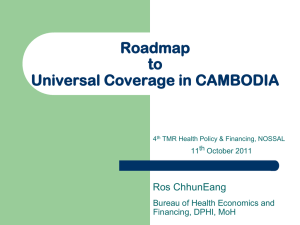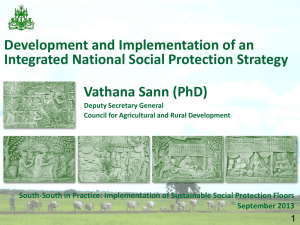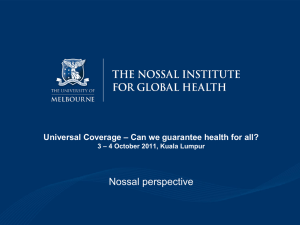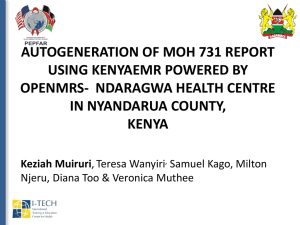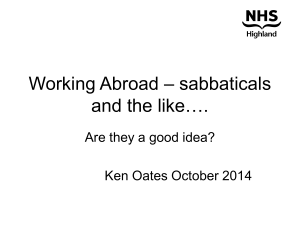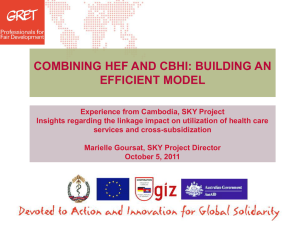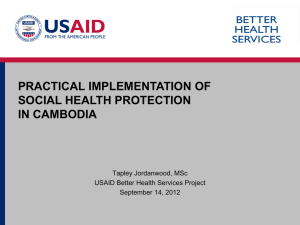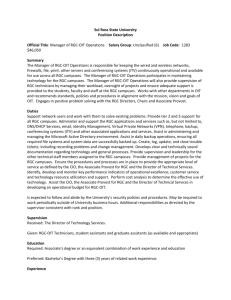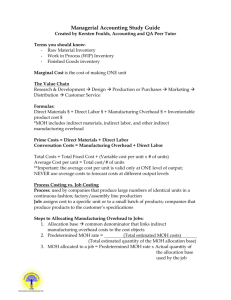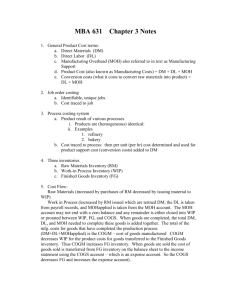SUMMARY: Medium-term issues and options for supply and
advertisement
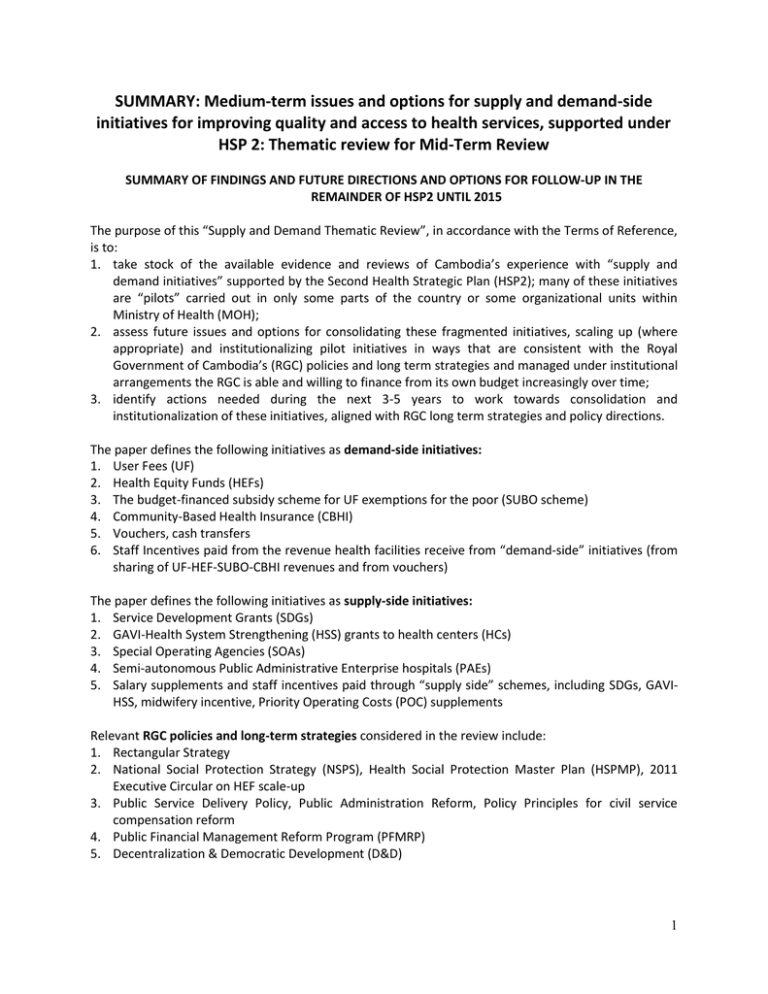
SUMMARY: Medium-term issues and options for supply and demand-side initiatives for improving quality and access to health services, supported under HSP 2: Thematic review for Mid-Term Review SUMMARY OF FINDINGS AND FUTURE DIRECTIONS AND OPTIONS FOR FOLLOW-UP IN THE REMAINDER OF HSP2 UNTIL 2015 The purpose of this “Supply and Demand Thematic Review”, in accordance with the Terms of Reference, is to: 1. take stock of the available evidence and reviews of Cambodia’s experience with “supply and demand initiatives” supported by the Second Health Strategic Plan (HSP2); many of these initiatives are “pilots” carried out in only some parts of the country or some organizational units within Ministry of Health (MOH); 2. assess future issues and options for consolidating these fragmented initiatives, scaling up (where appropriate) and institutionalizing pilot initiatives in ways that are consistent with the Royal Government of Cambodia’s (RGC) policies and long term strategies and managed under institutional arrangements the RGC is able and willing to finance from its own budget increasingly over time; 3. identify actions needed during the next 3-5 years to work towards consolidation and institutionalization of these initiatives, aligned with RGC long term strategies and policy directions. The paper defines the following initiatives as demand-side initiatives: 1. User Fees (UF) 2. Health Equity Funds (HEFs) 3. The budget-financed subsidy scheme for UF exemptions for the poor (SUBO scheme) 4. Community-Based Health Insurance (CBHI) 5. Vouchers, cash transfers 6. Staff Incentives paid from the revenue health facilities receive from “demand-side” initiatives (from sharing of UF-HEF-SUBO-CBHI revenues and from vouchers) The paper defines the following initiatives as supply-side initiatives: 1. Service Development Grants (SDGs) 2. GAVI-Health System Strengthening (HSS) grants to health centers (HCs) 3. Special Operating Agencies (SOAs) 4. Semi-autonomous Public Administrative Enterprise hospitals (PAEs) 5. Salary supplements and staff incentives paid through “supply side” schemes, including SDGs, GAVIHSS, midwifery incentive, Priority Operating Costs (POC) supplements Relevant RGC policies and long-term strategies considered in the review include: 1. Rectangular Strategy 2. National Social Protection Strategy (NSPS), Health Social Protection Master Plan (HSPMP), 2011 Executive Circular on HEF scale-up 3. Public Service Delivery Policy, Public Administration Reform, Policy Principles for civil service compensation reform 4. Public Financial Management Reform Program (PFMRP) 5. Decentralization & Democratic Development (D&D) 1 During the first half of the Second Health Strategic Plan (HSP2), the RGC has some adopted laws and policies that confirm and clarify the direction for some key long term strategies that will affect the health sector over the next 10 years and beyond. During the second half of HSP2, it will be important for the Ministry of Health (MOH) and development partners (DP) to adjust existing initiatives and institutional arrangements in line with these RGC policies. A. Demand-Side Health Financing Initiatives (HEFs, SUB, CBHI, vouchers): consolidating health financing initiatives and institutionalizing initiatives currently implemented by NGOs and DPs - Key Findings: 1. RGC’s long term direction is to establish a social health insurance (SHI) system, beginning with HEF scale-up and NSSF for private sector, followed later by NCSSF for civil servants. Voluntary CBHI will be promoted to offer coverage to the informal sector. This direction has been confirmed over a number of years in a series of strategies, a law and other policy instruments of the RGC at the highest level, though detailed design of implementation and transition path are not yet fully elaborated. 2. It seems clear that the RGC will not channel its budget subsidies for HEFs through NGO HEF implementers (HEFIs), except for its counterpart contribution to DP-financed programs. In order to achieve institutionalization of HEFs and CBHI by the end of HSP2, it is now urgent to establish a public institution to implement HEF and CBHI, so that the transition can begin for hand-over of NGO HEFI functions, systems and capacity to an RGC public institution. This could be established to prepare for transition in parallel with steps to establish the Social Health Protection umbrella body at the level of the Council of Ministers which will oversee the social health insurance (SHI) system, as envisaged in the SHPMP. 3. There will be continuing, important role for supply-side budget finance even after SHI is fully implemented, and a crucial role during the transition to universal SHI. This role will need to be reviewed and clarified. Countries with universal SHI systems typically use budget finance for MOH stewardship functions, some key public health functions and programs, pre-service training, other strategic training, management and systems development, research and subsidies for the poor. Many countries with SHI systems continue to use budget finance for major capital expenditure on health facilities and salaries and allowances of civil servants working in heath facilities – at least for a transition period. 4. MOH & DPs should plan to consolidate funding for recurrent costs of service delivery into 2 channels: (i) demand-side subsidies for HEF/CBHI and complementary voucher or cash transfer schemes; and (ii) supply-side financing aligned with the RGC budget law, sub-decrees and MEF prakas. 5. Scaling up CBHI will be slow unless it is subsidized and in future becomes mandatory - Future Directions and Options: Progressive shift of financing for recurrent costs of health care from “supply side” (MOH budget for inputs) to “demand side” (SHI, with tax subsidies for SHI for the poor and perhaps partial subsidies for near-poor). 2. Establishment of a public institution to implement HEF and CBHI: e.g. a National Social Security Funds for the Subsidized schemes (“NSSF-S”). The option of establishing this type of institution as a PAE under MOH and MEF by sub-decree could speed up preparation for implementation This could 1. 2 preparation could begin in parallel with adoption of a law on social health protection for all of the citizens of Cambodia who are not covered by the existing Social Security Law and the establishment of the umbrella body at the level of the Council of Ministers to oversee the whole SHI system. 3. Transfer of NGO HEFI functions, systems, capacity and SUB scheme functions to this “NSSF-S” public institution could begin with the aim of full transfer before the end of HSP2. 4. Development of Law and sub-decrees for future HEF/CBHI and National Social Security Fund for civil servants (NCSSF) 5. Clarification of RGC policy on future role for sub-contracted NGO and CBO HEFO/CBHI operators, and future role of local administration after D&D. The future “NSSF-S” public institution could subcontract some HEFO and CBHI operational roles to local NGOs, Community Based Organizations (e.g. in Angkor Chum) and district and municipality administrations. This would facilitate HEF scale-up. 6. Consideration of options for “who finances what” – clarifying which costs should be covered by the demand-side (SHI system and UF) versus supply-side financing of inputs by MOH – during the transition to SHI and in the longer term. There are many combinations of options that could be considered, each with advantages and disadvantages. There will also be a need for coordination between MOH budget allocation and the SHI system. For example, if the MOH budget finances major capital expenditure and if CAR/ MEF continue to allocate civil service personnel quota and set their salaries, there will be a need for coordination with SHI in relation to the recurrent cost implications. 7. Intensification of MOH work program (already started) on the following: (i) updated MPA and CPA costing (ii) review of health financing charter (basis for setting UF) and Prakas for use of UF and HEF/CBHI income; (iii) review of benefit package for HEF/CBHI/NSSF/NCSSF; in particular, the review needs to look at current exclusions of communicable disease programs that are currently free and at options for some of the current inclusions (e.g. village-to-health facility transport, which could alternatively be provided by voucher schemes or by Commune/Sangkat (C/S) funds (iv) review of provider payment methods for MPA and CPA 8. Because scale-up of CBHI and coverage of informal sector may take a long time, MOH needs to review and decide among options for protecting the near-poor informal sector from catastrophic healthcare costs during transition to universal coverage of SHI. Options include: (i) HEF coverage extended to near -poor for high cost treatments/catastrophic costs; (ii) higher supply side subsidies to health facilities to keep user fees low , especially for high cost cases; (iii) UF exemptions for near-poor for high cost treatments, financed by cross-subsidy from other funds; (iv) Subsidized CBHI premiums, and in future consider making CBHI mandatory. B. SDGs, SOAs and other internal performance contracting - Key Findings 1. SDGs or HSS performance contracting through the “supply side” is unlikely to be financed from RGC budget funds in the longer term. Section D of this Review discusses the main reason why: SDG staff incentives conflict with the RGC’s principles for civil service compensation reform. 2. Internal contracting fragments recurrent cost financing and commissioning, leading to inefficient duplication of contracting, monitoring, accounting, reporting. It does not make sense to have both 3 internal contracting and external (SHI-based) contracting systems, particularly given that these are paying for the same inputs to the same services for the same people. 3. It is possible to have SOAs without SDGs, with external contracts with SOAs replacing the current role of internal contracts. However, SOAs for ODs may not have a long term future under D&D Organic Law. ODs may be unbundled and some of their functions transferred to administrative districts and municipalities in the longer term when decentralization (D&D) is implemented. - Future Directions and Options 1. SDGs for RHs could be replaced by HEF/CBHI scale up (after review of health finance charter, UF prakas, CPA costing, provider payment methods). 2. Program-based budgeting (PBB) could also replace part of the function of SDGs in the short term, through PBB cannot be used to finance staff incentives. 3. SDGs for MPA could be replaced by HEF/CBHI scale up (& PBB) if HEFs introduce adjusted capitation payment method and if the HEF benefits package includes CD programs that currently don’t attract UF, such as HIV/AIDS, tuberculosis and malaria diagnosis and treatment. 4. Development of commissioning capacity in the future HEF/CBHI public institution (with linkages and cooperation with the MOH in relation to any costs still financed from the supply-side) 5. SOA status (with external contracting through HEF/CBHI instead of SDG) could be used to improve management capacity and systems in non-SOA ODs and RHs 6. MOH could explore with the National Council on Decentralization and Democratic Development (NCDD) options for creating a legal basis for groups of districts/municipalities to set up local public institutions similar to SOAs/PAEs to keep OD functions together after D&D C. Semi-autonomous hospitals: Public Administrative Enterprises (PAEs) and SOAs - Key Findings 1. All MOH hospitals have high autonomy/ weak accountability over UF/HEF revenue & low autonomy/ strong control over supply-side budget revenue and civil service personnel. This “hybrid” model of hospital autonomy creates inequity and perverse incentives, and weakens management of performance 2. Hospital autonomy for PAEs is widely misunderstood to mean cuts in budget finance, increases in user fees, & end of obligation to report financial information to MOH. The recent experience of China and Vietnam highlights that giving public hospitals the goal of increasing revenue or profit can lead to high catastrophic costs and to reluctance of staff to work in non-fee-generating, non-profitable services. - Future Directions and Options 1. Develop a comprehensive hospital autonomy policy and strategy covering: objectives of public hospitals, governance, the right balance between central guidance versus management autonomy in all domains of management, monitoring, accountability, private patient services, Public-Private Partnerships. 2. Review PAE and SOA sub-decrees based on this policy and strategy, seeking to incorporate good management practices from the best performing PAEs and SOAs and lessons from hospital autonomy in the region. 3. Strengthen capacity of PAE boards and hospital managers, develop management systems including HMIS, financial, clinical quality/safety. 4. In collaboration with MEF, develop unitary, consolidated accounting policies and systems for autonomous hospitals covering all sources of finance 4 D. Salary supplements and staff incentives - Key Findings 1. POC, SDG & HSS incentives conflict with RGC principles for civil service compensation reform. These principles are coverage, uniform rules across Ministries for additions to basic pay, concentration of remuneration in basic pay, equity, and fiscal sustainability. It seems almost certain that RGC will not finance these type of staff incentive schemes from its own budget (except as project counterpart funds). 2. RGC permits supplements financed from demand-side revenues or non-budget revenues in many sectors. Supplements paid from UF/HEF are likely to be consistent with RGC policy and more fiscally sustainable. 3. Distributing 60% of each health facility’s UF-HEF to its own staff leads to inequity, disincentives to work in remote areas or in CD programs and as UF increase, it will lead to profit-driven over-provision of profitable services. The policies for distribution of UF-HEF to staff need review based on RGC policy principles for compensation reform, good practices in some SOAs and evidence from other countries. 4. Fragmented incentives continue in some hospitals in spite of SD206 and cause jealousy and noncooperation among staff. 5. There is a wide variety of SDG incentives schemes. HSS incentives and the Midwifery Incentive operate under different rules. There is very little evidence about the impact of staff incentives. Some studies suggest non-targeted activities are relatively neglected. Some studies suggest impact on targeted activities may plateau or even decline after an initial surge. International evidence points to the need for caution in using powerful activity-based financial incentives for complex activities, such as CPA services. 1. 2. 3. 4. 5. 6. - Future Directions and Options Updated pay research on health worker income could be used to help RGC design new salary & allowance scale for MOH. May need different scales for some skill categories. Rural service allowances would need to be addressed in a uniform way for all sectors of government. It will be important for MOH to provide input to RGC debate on the phasing of civil service compensation reform: sector -by -sector phasing could benefit MOH. Alternatively phasing in reform starting with grades/skills/positions with biggest recruitment/retention problems could also benefit MOH. Transition path options for staff receiving high SDG incentives (higher than POC/PMG scale) need consideration. There is a wide range of incentives across different SOAs for the same posts/grades. MOH could consider the option of using UF/HEF revenue to finance early implementation of a new salary and allowance scale for MOH staff, in coordination with CAR and MEF. MOH could consider options for including “back-office “ staff in early implementation – for example by pooling a percentage of all UF-HEF revenue at central, PHD and OD level. MOH (in cooperation with CAR) could design a salary grid and revised allowances to be financed by top-ups to existing salary/allowances financed from UF-HEF . May need phasing in as UF-HEF/CBHI revenue grows. The transition path from donor support for “supply side” incentives to increased donor support for HEF/CBHI and hence “demand side” financing of incentives should be planned to be completed before the end of HSSP2 and GAVI-HSS programs. Ideally, plans could be agreed and announced before the end of the POC program, to give POC staff some confidence about future total compensation from the MOH. Central MOH guidelines could be developed for limited performance bonuses based on “SMART” principles: Specific, Measurable, Achievable, Relevant to strategic objectives, and Time-limited. These guidelines would need to be tailored for CPA , MPA, management, “back office” staff, based on evidence about the effects of performance payments for these different types of roles. 5 7. Donor & NGO incentives could be consolidated into support for HEF/CBHI & civil service compensation reform implementation. 8. Any unconsolidated incentives that continue to operate outside RGC/MOH policy frameworks could be pooled with UF-HEF revenues and distributed in the same way. 9. Re-designed salary & allowance scale should be factored into the ongoing costing of CPA and MPA, and into review of health finance charter and UF policy. Final Words of Caution The TORS for this Thematic Review were ambitious and cover a number of very complex and sensitive issues. There are gaps in the available evidence. Some relevant RGC policies are still undergoing further elaboration and implementation details are not yet decided. Many issues raised in the Review will require follow-up technical work, extensive consultation and policy debate within the MOH. Some issues go beyond the mandate of MOH, involving MEF, CAR and the COM. Similarly, the implications of some of the suggestions in the review for existing programs of DPs may go beyond only their health teams. The Review can only provide initial input to a long policy process, and a road-map for follow-up work. 6
